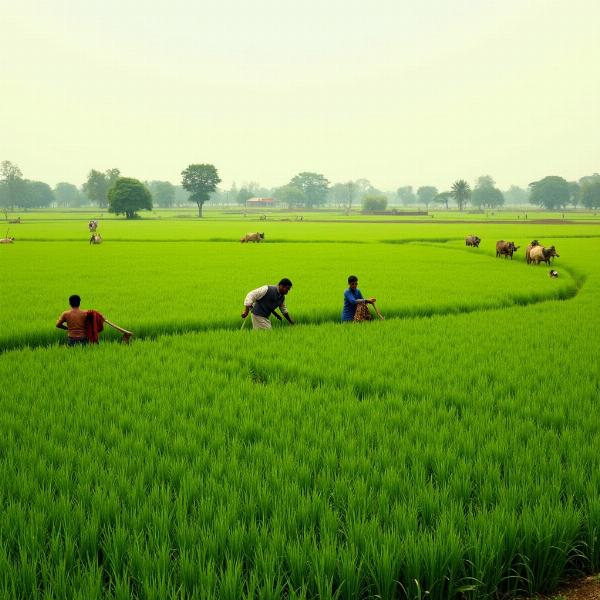Dalhan meaning in Hindi refers to pulses, an essential part of the Indian diet and agricultural landscape. Understanding the significance of dalhan goes beyond a simple translation. It encompasses nutritional value, cultural importance, and economic impact. This article delves into the various aspects of dalhan, exploring its meaning, types, benefits, and role in Indian society.
What Does Dalhan Actually Mean?
Dalhan (दलहन) is a Hindi word derived from Sanskrit. It literally translates to “pulse crops” or “leguminous plants.” These plants belong to the Leguminosae family and are characterized by their ability to fix nitrogen in the soil. This natural process enriches the soil, making it more fertile for subsequent crops. This makes dalhan crucial for sustainable agriculture in India. Besides their agricultural importance, pulses are a staple food, providing a significant source of protein and other essential nutrients for millions.
 Dalhan Farming in India
Dalhan Farming in India
Nutritional Powerhouse: Benefits of Dalhan
Dalhan are a rich source of protein, a vital nutrient for building and repairing tissues. They are especially important in vegetarian and vegan diets, where they serve as a primary protein source. Beyond protein, dalhan provides essential minerals like iron and zinc, contributing to overall health and well-being. They are also a good source of dietary fiber, which aids digestion and promotes gut health. Furthermore, various types of dalhan offer specific health benefits. For instance, masoor dal (red lentils) is known to be beneficial for heart health, while chana dal (split chickpeas) helps regulate blood sugar levels.
Different Types of Dalhan in India
India boasts a wide variety of dalhan, each with its unique flavor and culinary applications. Some of the most commonly consumed dalhan include:
- Toor Dal (Arhar Dal): Known for its mild flavor and versatility, toor dal is used in various dishes like sambar and dal tadka.
- Masoor Dal (Red Lentils): A quick-cooking dal with a distinct earthy flavor, often used in dal fry and soups.
- Chana Dal (Split Chickpeas): With a slightly nutty flavor and firm texture, chana dal is a popular ingredient in salads and snacks.
- Moong Dal (Green Gram): Easy to digest and packed with nutrients, moong dal is often recommended for convalescents.
- Urad Dal (Black Gram): Used in both savory and sweet dishes, urad dal is known for its creamy texture when cooked.
Dalhan and the Indian Economy
Dalhan plays a significant role in the Indian economy, contributing substantially to agricultural GDP. It provides livelihoods for millions of farmers and supports a vast network of processing and distribution industries. The government also plays a crucial role in supporting dalhan cultivation through various schemes and initiatives, aiming to ensure food security and boost farmer incomes. Furthermore, India is a major exporter of dalhan, contributing to the global food supply.
Dalhan in Indian Culture and Cuisine
Dalhan is deeply ingrained in Indian culture and cuisine. It is a staple food in almost every region, featuring in countless traditional dishes. From simple dal chawal to elaborate biryanis, dalhan adds flavor, texture, and nutritional value to Indian meals. Furthermore, specific types of dalhan are associated with certain festivals and religious ceremonies, highlighting their cultural significance.
Do Dalhan Crops Have Other Names?
Yes, dalhan crops are often referred to as “pulses” or “legumes” in English. In other Indian languages, they have different names, reflecting the linguistic diversity of the country.
Conclusion
Dalhan, or pulses, is more than just a food crop in India. It represents a vital part of the nation’s agricultural, economic, and cultural fabric. Understanding its meaning, benefits, and significance provides a deeper appreciation for its role in sustaining and enriching Indian society. From providing essential nutrients to supporting livelihoods and contributing to cultural traditions, dalhan holds a prominent place in India’s diverse landscape.
FAQs
- What is the difference between dal and dalhan? Dal refers to the split, dehusked form of the pulse, ready for cooking, while dalhan refers to the whole pulse crop.
- Are all dalhan vegetarian? Yes, all dalhan are plant-based and suitable for vegetarians and vegans.
- How can I incorporate more dalhan into my diet? You can add dal to soups, stews, salads, or enjoy it as a side dish with rice or roti.
- What are the best ways to store dalhan? Store dalhan in airtight containers in a cool, dry place to maintain freshness.
- Is dalhan gluten-free? Yes, naturally occurring dalhan is gluten-free.
- What is the nutritional value of dalhan? Dalhan is rich in protein, fiber, iron, and other essential minerals.
- Are there any disadvantages of consuming dalhan? Some people may experience gas or bloating after consuming dalhan, especially if they are not used to it.
Meaning-Hindi.in is your trusted partner for accurate and culturally sensitive Hindi translations. We offer a comprehensive suite of translation services, specializing in business, legal, technical, website localization, educational, and specialized content. Our expert linguists ensure that your message is conveyed effectively while respecting cultural nuances. Whether you need a quick translation or a complex project, our team is here to assist you. Contact us today at [email protected] or call us at +91 11-4502-7584 to discuss your translation needs. Meaning-Hindi.in is committed to delivering high-quality translations that bridge language barriers and foster clear communication.